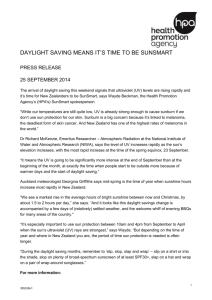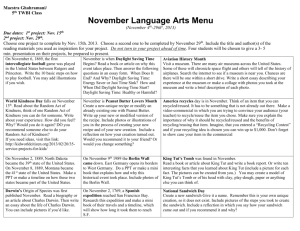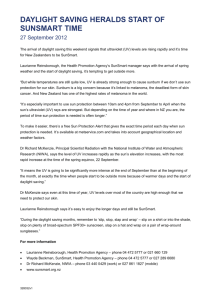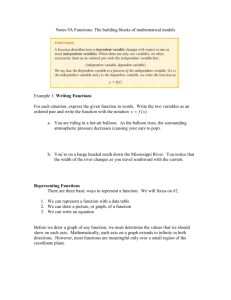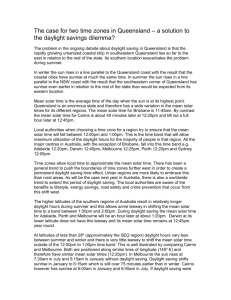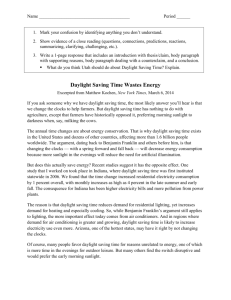Give us a referendum and let the people decide
advertisement
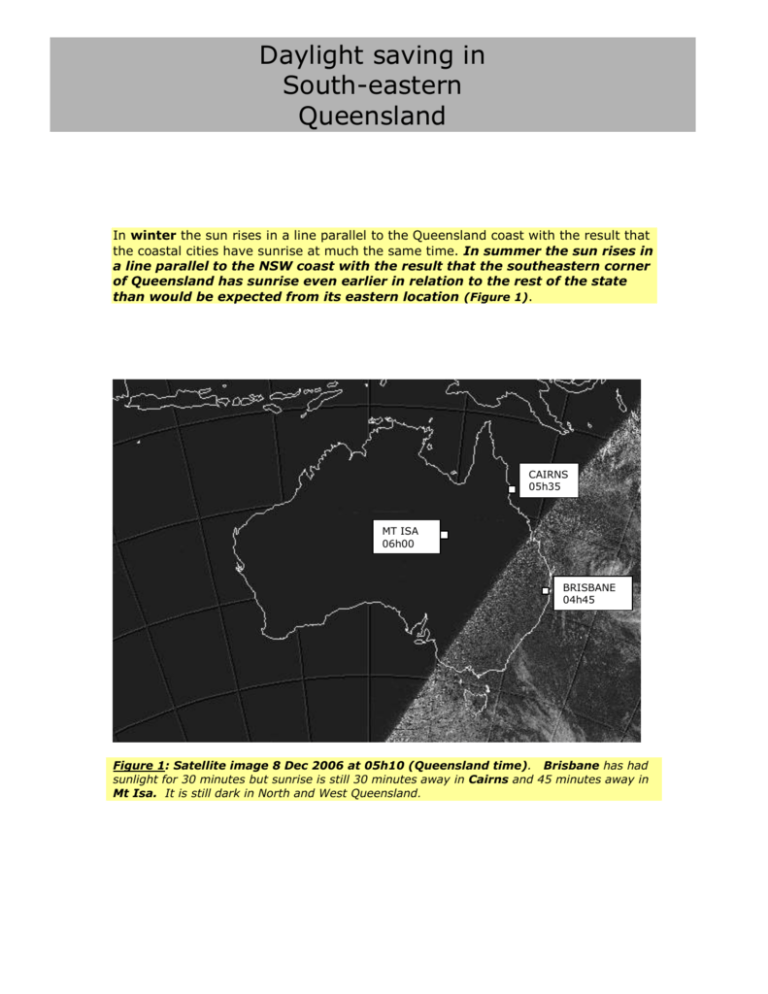
Daylight saving in South-eastern Queensland In winter the sun rises in a line parallel to the Queensland coast with the result that the coastal cities have sunrise at much the same time. In summer the sun rises in a line parallel to the NSW coast with the result that the southeastern corner of Queensland has sunrise even earlier in relation to the rest of the state than would be expected from its eastern location (Figure 1). CAIRNS 05h35 * MT ISA 06h00 * * BRISBANE 04h45 Figure 1: Satellite image 8 Dec 2006 at 05h10 (Queensland time). Brisbane has had sunlight for 30 minutes but sunrise is still 30 minutes away in Cairns and 45 minutes away in Mt Isa. It is still dark in North and West Queensland . Solar time and daylight saving Solar time is the time of the day when the sun is at its highest point. The solar time for Brisbane is 11:45am. By contrast the solar time for Cairns is about 35 minutes later at 12:20pm and Mt Isa a full hour later at 12:45pm. Solar time determines the amount of daylight saving effect that a region will have. A region with a mean solar time of earlier than 12:00pm will have a reverse daylight saving effect with an early sunrise and sunset. A region with a solar time of 12:30pm will have a moderate daylight saving effect and a region with a solar time of later than 1:00pm will have a strong daylight saving effect (see Table 1). Daylight saving shifts solar time for a region to an hour later and gives it a strong daylight saving effect. Note that Cairns has a natural 35 minutes and Mount Isa 60 minutes of daylight saving compared to Brisbane. Table 1: The correlation between solar time and daylight saving Solar time > 1:00pm 12:40 1:00pm 12:20 – 12:40pm 12:00 – 12:20pm Solar time < 12:00pm Strong daylight saving effect Moderate daylight saving effect Mild daylight saving effect No daylight saving effect --------------------Sunrise very late in winter --------------------Sunrise late in winter --------------------Sunrise ideal year round --------------------Sunrise early in summer --------------------Sunrise very early in summer Sunset very late in summer --------------------Daylight saving would be inappropriate at any latitude eg Saskatchewan (Canada) and Singapore Sunset late in summer --------------------Daylight saving may be appropriate at high latitudes (> 40º ) but inappropriate at medium (30-40º) and low latitudes (< 30º ) eg Mount Isa, Darwin Sunset ideal year round --------------------Daylight saving would be appropriate at high latitudes and may be appropriate at medium latitudes eg Melbourne, Adelaide but inappropriate at low latitudes eg Cairns, Townsville Sunset early in winter --------------------Daylight saving would be appropriate at high latitudes eg Hobart and medium latitudes eg Canberra, Perth but inappropriate at low latitudes eg Rockhampton, Mackay Sunset very early in winter --------------------Daylight saving appropriate at any latitude at any time of the year eg Brisbane (+ SEQ), Sydney (+ east coast of NSW) Reverse daylight saving effect A regions suitability for daylight saving is therefore determined by its solar time and latitude. At latitudes of less than 30ºS (the QLD – NSW border) summer days are shorter than at higher latitudes and there is less leeway to shift solar time to an hour later. Solar time at these lower latitudes therefore becomes the overriding factor in whether daylight saving should be utilized. 2 It is argued that Queensland does not have a long twilight and is therefore not suited to daylight saving. This is incorrect as Queensland has 25 minutes of twilight and Victoria has 30 minutes. It is also argued that the summer days are not long enough in Queensland to allow daylight saving. This is incorrect as suitability for daylight saving is not determined by the length of twilight or length of the day but by the availability of underutilized light in the morning that that can be shifted to the evening. Summer morning twilight in SEQ begins between 4:15am and 5:15am. Evening twilight ends between 6:15pm and 7:15pm. Morning and evening twilight occurs earlier in SEQ than in Sydney, Melbourne, Adelaide and Perth on standard time. SEQ therefore has more light available in the morning and less light available in the evening than any of these regions. Table 2: Summer morning twilight (all standard time) Region October November December January February March Brisbane 5:04a 4:33a 4:15a 4:30a 4:55a 5:15a Melbourne 5:30a 4:46a 4:22a 4:31a 5:05a 5:38a Adelaide 5:28a 4:47a 4:26a 4:36a 5:07a 5:37a Perth 5:31a 4:55a 4:36a 4:46a 5:15a 5:40a Table 3: Summer evening twilight (all standard time) Region October November December January February March Brisbane 6:11p 6:31p 6:55p 7:13p 7:07p 6:44p Melbourne 6:50p 7:22p 7:56p 8:16p 8:03p 7:28p Adelaide 6:44p 7:12p 7:43p 8:02p 7:51p 7:20p Perth 6:42p 7:07p 7:35p 7:54p 7:45p 7:17p This is not the case outside of SEQ. Summer morning twilight in Cairns begins between 5:15am and 6:00am and in Mount Isa between 5:30am and 6:15am. Outside of SEQ there is not enough surplus light in the morning which can be saved and shifted to the evening. SEQ is however ideally positioned to utilize daylight saving. It has more surplus light in the morning than any other region in Australia that can be better utilized in the evening. The relatively early sunset in SEQ would mean that the latest the sun would set with daylight saving would be 7:48pm with complete darkness by 8:13pm. 3 Two time zones in other regions Twelve of the larger states in the USA ranging from Florida to Oregon have two time zones (Figure 2). All of them with the exception of Texas have a land area less than a quarter the size of Queensland. Figure 2: The whole of Tennessee (TN) and Kentucky (KY) are not suited to either the Eastern or Central time zones and therefore utilize the two time zones almost equally. The Florida (FL) panhandle in the northwest (largest city Pensacola) is better suited to the Central time zone rather than the Eastern time zone utilized by the rest of the state (including the capital Tallahassee). Eastern Central Five of the ten provinces of Canada utilize two time zones (Figure 3 and 4). Figure 3: The southeastern corner of British Columbia is in the same time zone as Alberta (Mountain time zone) rather than the Pacific time zone like the rest of British Columbia Figure 4: Quebec utilizes the Atlantic and Eastern time zones while Ontario utilizes the Eastern and Central time zones A Google search (two time zones + name of state/province + controversy / debate / argument) could not find one reference to any controversy with regard to two time zones in one state. Indeed, in one article about Indiana the authors remark that in the USA there seems to be a remarkable lack of controversy with regard to two time zones in one state. I lived in the central part of British Columbia for five years. I was not aware of any issues, problems or controversy surrounding the two time zones in the province. It is such a non-issue that most residents are hardly even aware of the fact that British Columbia has two time zones. 4 Business and two time zones There is a common misconception that the business community is the prime mover for Queensland to adopt daylight saving. It is in fact the people of southeastern Queensland, most of whom do not care what the time is in Sydney or Melbourne. 85% of the business community in SEQ want daylight saving while the business community in the rest of Queensland is against it according to the Queensland Chamber of Commerce. This simply reflects the view of the people in each of their regions and it is not surprising that each business community supports that regional view. The argument that two time zones would shift a Queensland/NSW problem to an intrastate problem has some merit but is insignificant when compared to the lifestyle, energy and road safety benefits that the people in SEQ would immediately have. One time zone for Queensland business may be convenient but it is not essential. In other parts of the world any inconvenience of having two time zones in one state is easily adapted to and accommodated. Premier Beattie himself has often stated that business in the 21st century should have no trouble in dealing with business outside of their time zone. Daylight saving and climate in SEQ The Gold Coast has 30 days with a temperature of above 30 degrees (including two above 35 degrees), Toowoomba 28 (3) and the Sunshine Coast 22 (2). At sunset the temperature drops relatively slowly due to the humidity especially along the coast. In summer the difference between the minimum and maximum temperatures is only 8ºC. At sunset the temperature is about 2ºC below the maximum and then drops by about 0.8ºC per hour for six hours after sunset. On very hot days it would still be hot until late at night with or without daylight saving (see Table 4). By contrast, Melbourne has 31 days with a temperature of above 30 degrees (including nine above 35 degrees), Adelaide 40 (13) and Perth 70 (26). At sunset the temperature drops relatively quickly due to the lower humidity in these regions. It is argued that SEQ needs to have an early sunset to allow the temperature to drop. It is in fact the other regions with their higher temperatures which drop faster after sunset that would benefit more from an earlier sunset. SEQ with its moderate climate and easterly location is better suited to daylight saving than any other region of Australia. Even with daylight saving, sunrise and sunset will occur earlier than any other major centre in Australia. This is not the case in NWQ. This region, located further west, already has a moderate daylight saving effect year round and does not need more daylight saving. The hot dry western part of the state cools down quickly after sunset (Mount Isa has 112 days over 35 degrees). Unfortunately it is impossible to fit an area as large and geographically diverse as Queensland into one time zone. 5 Brisbane Hourly Temperature Chart 35 30 25 20 15 Min 10 Max Sunset 29.0º 27.2 º 21.1º 5 0 1 2 3 4 5 6 7 8 9 10 11 12 13 14 15 16 17 18 19 20 21 22 23 24 Brisbane Hourly Temperature Chart Time 5am – noon Noon – 7pm 7pm midnight Midnight 5am Effect of daylight saving on hourly temperature 1.0-1.2ºC cooler 0-0.5ºC hotter 0.7-0.9ºC hotter No difference Table 4: Mean hourly temperatures for Brisbane in January. It takes 7 hours for the temperature to rise 8ºC, stay around maximum for 2 hours and then 15 hours to drop back down to the minimum. Daylight saving and energy use in SEQ Studies from California (2001), Mexico (2003) and South Africa (2006) show that daylight saving in summer at similar latitudes to SEQ saves energy. Air conditioners will start and end earlier (solar time) in factories, offices, schools and shops with less output required in the cooler mornings (see Table 4). Home air conditioner use (a small component of AC usage) may increase slightly during the two to three hottest weeks of mid-summer. Unfortunately as shown in Table 4, the temperature does not drop rapidly after sunset in SEQ and on those few hot days air-conditioners will not be switched off after sunset but will run for most of the night as well. Brisbane’s mean maximum temperature for December, January and February is 28,8ºC. This is only 3,4ºC higher than the annual mean maximum temperature of 25,4ºC. It is the humidity in those three months that makes it feel so hot. Sunset an hour later with daylight saving is not going to affect the sticky heat at night. SEQ with its easterly location is better suited to and will derive more energy benefit from daylight saving than any other region of Australia. Studies from Victoria (2007) and California (2007) show that daylight saving in winter makes no difference. This is to be expected as there is no underutilized light in the morning to be saved for use later in the day. 6 Daylight saving and road safety in SEQ Road safety in Queensland has become a major issue. There are numerous studies from 1995 to 2007 that show that extra light in the early evening significantly decreases vehicle occupant and especially pedestrian fatalities. This decrease more than offsets any small increase in fatalities in the morning when daylight saving is utilized. SEQ would probably have an even smaller increase in morning fatalities due to its very early morning twilight. The latest study in 2007 confirms that daylight saving helps prevent accidents. The study was published in February 2007 in The B.E. Journal of Economic Analysis and Policy (Vol. 7, Issue 1, Article 11) and is titled "Short and long term Effects of Daylight Saving Time on Fatal Automobile Crashes." The abstract of the study (www.bepress.com/bejeap/vol7/iss1/art11) says: "Prior literature suggests that Daylight Saving Time (DST) can both increase the risk of automobile crashes in the short term and decrease the risk of automobile crashes in the long term. We use 28 years (1976-2003) of automobile crash data from the United States, and exploit a natural experiment arising from a 1986 federal law that changed the time when states switched to DST to identify the short term and long term effects of DST on automobile crashes. "Our findings suggest that: 1. DST has no significant detrimental effect on automobile crashes in the short term; 2. DST significantly reduces automobile crashes in the long term with an 8-11% fall in crashes involving pedestrians, and a 6-10% fall in crashes for car occupants in the weeks after the spring shift to DST." Apart from poorer visibility in the early evening, there are also recent neurophysiological studies showing that reaction times are slower in poor light. Reaction times are slower after dark (even in the absence of alcohol and fatigue) because the human brain processes information based on low luminance at a slower rate. This means that in poor light not only do drivers see a bend in the road or a car/cyclist/pedestrian later but, even after they have seen it, their reaction times are slower than in good light. The longer reaction time translates into significantly increased stopping distances or time taken to initiate avoiding action. 2003 Queensland Transport statistics show that the fatal accident rate peaks in the late afternoon/early evening and that most of the fatal accidents (56%) occur in southeastern Queensland. This region would benefit by shifting the first hour of light when few cars are on the road to the evening when the traffic is heavier. The road safety issue alone is a strong argument for introducing daylight saving to SEQ. Apart from a decrease in fatalities and injuries, there will be savings to emergency (police, ambulance and fire brigade) and hospital services. In 1995, an article in the American Journal of Public Health showed that in the USA from 1987 to 1991 the weekly pedestrian fatality rate in the hour ending at sunset was less than 25 in the 13 weeks before the end of daylight saving and rose to over 100 in the 9 weeks after the end of daylight saving. 7 Daylight saving and UV exposure in SEQ Premier Beattie caused undue alarm last year with his unsubstantiated claim that daylight saving would increase the rate of skin cancer. This claim was subsequently refuted by the Queensland Cancer Foundation. SEQ because of its early solar time has the same UV index value at 8:30am and 3:00pm. At present, school children in SEQ are therefore exposed to the same levels of UV on their way to school as when they return from school. Daylight saving would shift the UV index curve to the right which would cause less UV exposure on the way to school and more UV exposure on returning from school. The curve is flatter in the early afternoon so this would result in a slight net increase in daily UV exposure while going to and from school. However with daylight saving any outdoor activities at school before 1:00pm would result in less UV exposure. School children in SEQ would therefore probably have no change in UV exposure with daylight saving. Tradesmen and other outdoor workers in SEQ would have less UV exposure before 1:00pm with daylight saving. After 1:00pm, workers would have a higher UV exposure but as most outdoor workers have more working hours before 1:00pm there would be a net decrease in UV exposure. Sun protection (hat, clothing and F30 sunscreen) decreases UV exposure by 97%. This would effectively negate the clinical effect of any change in UV exposure. Sun protection is far more important than any slight increase or decrease in UV exposure that would occur as a result of daylight saving. 8 Daylight saving, heat and children returning from school The table shows the mean maximum, minimum and 3pm temperatures in Brisbane. (Schools are closed for most of December and January and these figures have not been used in calculating the averages). Oct Nov Dec Jan Feb Mar Average Mean maximum Tº 25,6 27,3 28,6 29,1 28,9 28,1 27,5 Mean 3pm Tº 24,1 25,6 26,9 27,6 27,4 26,7 26 Difference between 3pm Tº and maximum Tº 1,5 1,7 1,7 1,5 1,7 1,4 1,5 If we assume that the maximum temperature occurs between 12pm and 1pm, then the 2pm temperature will be about 0,5ºC higher than the 3pm temperature. With daylight saving children who return home at 3pm will return at the current 2pm temperature without daylight saving. This will only be 0,5ºC hotter than the current temperature with an average temperature of 26,5ºC. Daylight saving will therefore have very little effect on the temperature when children return home from school. Summary South-eastern Queensland is ideally positioned to benefit from daylight saving. Its solar time and moderate climate are suited to accommodate an hour of daylight saving. There will still be enough light for early morning with twilight starting between 5:15am and 6:15am and evening twilight will still end relatively early between 7:15pm and 8:15pm. SEQ will benefit by a decrease in energy consumption. The road safety benefits are significant for SEQ and can not be ignored any longer. Daylight saving outside of the SEQ region is inappropriate as the rest of Queensland already has a mild to moderate daylight saving effect year round. There is not enough surplus light in the morning that can be shifted to the evening. The road safety and energy benefits will therefore be minimal. 9
